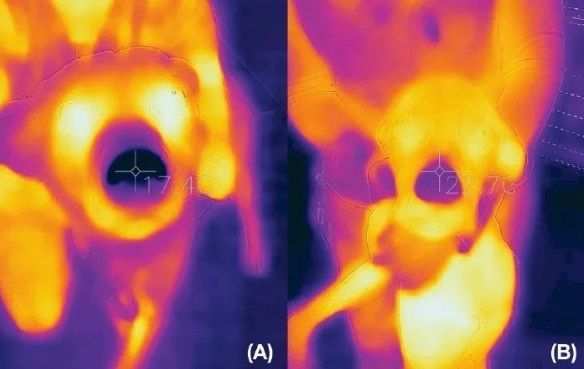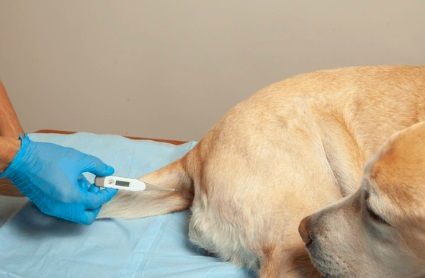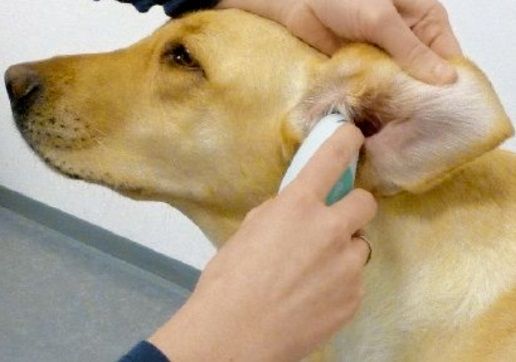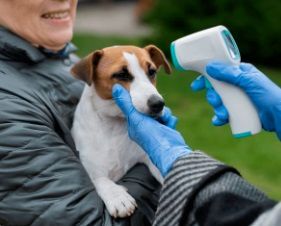Temperatura corporal
Qual a temperatura corporal normal?
Por que mensurar a temperatura corporal dos cães e gatos?
Como mensurar a temperatura corporal dos cães e gatos?
Termômetros de contato
Termômetro infravemelho sem contato
Introdução
Os termômetros infravermelhos sem contato, que ganharam popularidade em 2020 em grande parte devido à pandemia de SARS-COV-2, utilizam sensores piroelétricos para medir a radiação eletromagnética natural que emana do organismo.
A radiação eletromagnética natural depende da temperatura corporal para ser emitida.
Vantagens
As vantagens da utilização do termômetro infravermelho sem contato são a velocidade da mensuração, conveniência, diminuição do estresse ao paciente e menor possibilidade de ocorrer lesão aos profissionais por mordidas ou arranhaduras ocasionadas pelos pacientes.
Desvantagens
Baixa consistência e não fornece resultados confiáveis:
O resultado obtido da temperatura não é confiável para os cães e gatos, pois o termômetro infravermelho sem contato fornece resultados inconstantes.
Necessita de calibração constante do aparelho:
O termômetro sem contato descalibrado pode apresentar variação de até 3°C e requer calibragem ocasional, mas nem todos os termômetros apresentam a possibilidade de ser calibrado.
Não identifica adequadamente hipertermia ou hipotermia:
Com a mensuração da temperatura corporal com termômetro infravermelho sem contato, há a possibilidade de não identificarmos adequadamente os pacientes com hipertermia ou hipotermia, que são importantes condições nos pacientes, principalmente os que estão em estado crítico.
Superestima a temperatura corporal:
O termômetro infravermermelho sem contato superestima a temperatura corporal em pacientes com hipotermia.
Subestima a temperatura corporal:
Além de subestimar altas temperaturas corporais, a mensuração da temperatura corporal com termômetro infravermelho sem contato subestima a temperatura corporal em 1 a 8,3° C em pacientes com temperatura retal normal, independentemente da área de mensuração.
Baixa correlação com a temperatura retal:
Os termômetros infravermelhos sem contato apresentam baixa correlação com a temperatura retal e não fornecem resultados confiáveis.
A razão para a baixa correlação entre o termômetro infravermelho sem contato com a temperatura retal é desconhecida, mas acredita-se que seja por:
Variação de temperatura da pele:
A alta variação da temperatura da pele normal dos cães e gatos de um mesmo indivíduo e em um curto período de tempo diminui a precisão da mensuração da temperatura realizada pelo termômetro infravermelho sem contato.
A cor, densidade da pelagem e a massa muscular interferem na leitura da mensuração da temperatura do aparelho:
O pelo impede a adequada detecção de emissão radiação eletromagnética da pele.
Utilização em seres humanos:
O aparelho foi projetado para realização em seres humanos, embora alguns pesquisadores tenham realizado experimento com termômetro infravermelho sem contato modificado para utilização em cães e gatos.
Variação no fluxo sanguíneo e emissão de radiação eletromagnética:
A variação no fluxo sanguíneo arterial e emissão de radiação eletromagnética em cães e gatos são diferentes dos seres humanos e o aparelho pode diminuir a sua precisão.
Consenso
Não é recomendado utilizar o termômetro infravermelho sem contato nos cães e gatos, independentemente do local de mensuração da temperatura corporal, e não deve ser utilizado como substituto para a mensuração da temperatura retal.
O consenso é de que a mensuração corporal realizada na membrana timpânica não deve ser utilizada e não deve substituir a mensuração da temperatura retal em cães e gatos, mesmo utilizando o termômetro infravermelho específico para os animais.
Fatores que interferem na temperatura corporal
Compartilhe com sua família e amigos!
Referências bibliográficas
- BAKER, J. A.; DAVIS, M. S. Effect of conditioning on exercise-induced hyperthermia and post-exercise cooling in dogs. Comparative Exercise Physiology, v. 14, n. 2, p. 91-97, 2018
- BARTON, J. C. A noninvasive method of temperature measurement using a noncontact handheld infrared thermometer fails to correlate with rectal temperature in dogs and cats. Journal of the American Veterinary Medical Association, v. 260, n. 7, p. 752-757, 2022
- BIONDI, F. et. al. Infrared ocular thermography in dogs with and without keratoconjunctivitis sicca. Veterinary Ophthalmology, v. 18, n. 1, p. 28-34, 2013
- BRAGG, R. F. et. al. Evaluation of the effects of hospital visit stress on physiologic variables in dogs. Journal of the American Veterinary Medical Association, v. 246, n. 2, p. 212-215, 2015
- CARTER, A. J.; HALL, E. J. Investigating factors affecting the body temperature of dogs competing in cross country (canicross) races in the UK. Journal of Thermal Biology, n. 72, p. 33-38, 2018
- CICHOCKI, V.; DUGAT, D.; PAYTON, M. Agreement of Axillary and Auricular Temperature with Rectal Temperature in Systemically Healthy Dogs Undergoing Surgery. Journal of the American Animal Hospital Association, v. 53, n. 6, p. 291-296, 2017
- CUGMAS, B. et. al. Comparison between rectal and body surface temperature in dogs by the calibrated infrared thermometer. Veterinary and Animal Science, v. 16, n. 9, p. 1-8, 2020
- FEITOSA, F. L. F. Exame Físico Geral ou de Rotina. In: FEITOSA, F. L. F. Semiologia Veterinária: a Arte do Diagnóstico, Editora Roca LTDA., terceira edição, São Paulo, 2014, p. 122-159
- GIANNETTO, C. et. al. Comparison of rectal and vaginal temperature daily rhythm in dogs (Canis familiaris) under different photoperiod. Biological Rhythm Research, v. 46, n. 1, p. 113-119, 2015
- GIANNETTO, C. et. al. Short Communication: Use of Infrared Thermometers for Cutaneous Temperature Recording: Agreement with the Rectal Temperature in Felis catus. Animals, v. 12,n . 10, p. 1-12, 2022
- GOIC, J. B.; REINEKE, E. L.; DROBATZ, K. J. Comparison of rectal and axillary temperatures in dogs and cats. Journal of the American Veterinary Medical Association, v. 244, n. 10, p. 1170-1175, 2014
- GONZÁLEZ, A. M. et. al. Measurement of body temperature by use of auricular thermometers versus rectal thermometers in dogs with otitis externa. Journal of the American Veterinary Medical Association, v. 221, n. 3, p. 378-380, 2002
- HALL, E. J.; CARTER, A. J. Comparison of rectal and tympanic membrane temperature in health exercising dogs. Comparative Exercise Physiology, v. 13, n. 1, p. 37-44, 2017
- JOLIVET, F. et. al. The use of thermometer protective sheets provides reliable measurement of rectal temperature: a prospective study in 500 dogs. Journal of Small Animal Practice, v. 61, n. 4, p. 216-233, 2020
- KAHNG, E.; BRUNDAGE, C. Comparing alternatives to canine rectal thermometry at the axillary, auricular and ocular locations. Open Veterinary Journal, v. 9, n. 4, p. 301-308, 2019
- KENNEDY, C. T.; BABYAK, J. M.; ROZANSKI, E. A. The Accuracy of tactile assessment of canine nose temperature to identify rectal hyperthermia and hypothermia in dogs presenting on an emergency basis. The Canadian Journal of Veterinary Research, v. 85, n. 3, p. 205-209, 2021
- KONIETSCHKE, U. et. al. Comparison of auricular and rectal temperature measurement in normothermic, hypothermic, and hyperthermic dogs. Tierärztliche Praxis Ausgabe K: Kleintiere/Heimtiere, v. 42, n. 1, p. 13-19, 2014
- KREISSL, H.; NEIGER, R. Measurement of body temperature in 300 dogs with a novel noncontact infrared thermometer on the cornea in comparison to a standard rectal digital thermometer. Journal of Veterinary Emergency and Critical Care, v. 25, n. 3, p. 372-378, 2015
- LOPEDOTE, M. et. al. Changes in Pulse Rate, Respiratory Rate and Rectal Temperature in Working Dogs before and after Three Different Field Trials. Animals, v. 10, n. 4, p. 1-8, 2020
- LUKKANAWARAPORN, Y. et. al. Effects of environment condition, size, coat type, and body condition score on rectal temperature prediction in dogs using infrared auricular and surface temperature. Veterinary World, v. 15, n. 5, p. 1314-1322, 2022
- MCNICHOLL, J.; HOWARTH, G. S.; HAZEL, S. J. Influence of the Environment on Body Temperature of Racing Greyhound. Frontiers in Veterinary Medicine, v. 3, n. 53, p. 1-13, 2016
- OMÓBÒWÁLÉ, T. O. et. al. A Comparison of Surface Infrared with Rectal Thermometry in Dogs. Nigerian Journal of Physiological Sciences, v. 32, n. 2, p. 123-127, 2017
- OSINCHUCK, S. et. al. Comparison between core temperatures measured telemetrically using the CorTemp® ingestible temperature sensor and rectal temperature in health Labrador retrievers. The Canadian Veterinary Journal, v. 55, n. 10, p. 939-945, 2014
- PICCIONE, G. et. al. Effect of Moderate Treadmill Exercise on Some Physiological Parameters in Untrained Beagle Dogs. Experimental Animals, v. 61, n. 5, p. 511-515, 2012
- REFINETTI, R.; PICCIONE, G. Daily Rhythmicity of Body Temperature in the Dog. Journal of Veterinary Medicine Science, v. 65, n. 8, p. 935-937, 2003
- Švantner, M. et. al. Study on Human Temperature Measurement by Infrared Thermography. Engineering Proceedings, v. 8, n. 1, p. 1-4, 2021
- SMITH, V. A.; LAMB, V.; MCBREARTY, A. R. Comparison of axillary, tympanic membrane and rectal temperature measurement in cats. Journal of Feline Medicine and Surgery, v. 17, n. 12, p. 1028-1034, 2015
- YANMAZ, L. E. et. al. Comparison of Rectal, Eye and Ear Temperatures in Kandal Breed Dogs. Kafkas Üniversitesi Veteriner Fakültesi Dergisi, v. 21, n. 4, p. 615-617, 2015
- ZANGHI, B. M. Eye and ear Temperature Using infrared Thermography are Related to Rectal Temperature in Dogs at Rest or With Exercise. Frontiers in Veterinary Medicine, v. 3, n. 111, p. 1-9, 2016
Atualizado em: 30/04/2024







